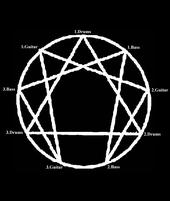ELECTRIC ENNEAGRAMM is a prevalently instrumental composition for three drum sets, three electric basses and three electric guitars set up in a circular formation.
The public will be seated on the floor, on cushions or a rug within the circle, but it will be able to move freely around the entire space, which will be illuminated by the light of numerous candles.
Each musician will have a speaker either behind or above him/her (in addition to the amplifier in the cases of the bassists and guitarists) from which only the part that that particular musician is playing will come out, allowing the public a three-dimensional listening of the composition, a diversification in the sound space in respect to the visual collocation of single executors.
The music exploits, on various levels, the resources offered by this type of formation: the juxtaposition of various harmonious and rhythmic planes, the construction of sonorous masses of varying weight and dimension, the mutation in the architecture of the sonorous masses and of the empty spaces, intertwined dynamics between the instruments and the apparent movement of these masses in the space, beyond a metamorphic musical discourse in the presence of elements already presented at the listening with new elements.
At the execution, scenic actions of varying types will take place (a sort of shaman which revolves around the public playing a rain stick, some musicians hidden among the audience that stand up performing improvisations, false signals of nervous disorders, a fake fight, people dressed in dark clothes that streak through the audience like fireflies until they are outside the circle of musicians, lights, etc.) for which the details will be indicated in the music score.
At the center, metaphorically and literally speaking, of this sound and visual experience is the audience, nearly obligated to be a part of this machine and subject to the pressure of a listening that goes beyond both the bi-dimensionality of the stereophonic system and the normal technical, behavioral and cultural praxis of live music; not only because the disposition of the musicians is unusual and the music surrounds the ears of the people instead of striking them only from the front, but also for the intention of convincing the public (by deliberately breaking the listening habits and scenic actions that open the visual and corporal dimension of the music) to react to this pressure.
This intention, in addition to the aesthetic, is, from certain points of view, anthropological and pedagogical. Starting with a critique in process on the language and cultural contexts of popular music, one arrives at the proposal of a sort of supercession model of the common perception of a given reality, which does not act on a symbolic level as representation in music of this model, but makes a particular experience in music the method through which to act directly upon the ears and psyche of the public, offering it a renewed perception of something that already recognizes and provokes a critical reaction. Like a reverse electrical shock, this experience attempts to stimulate intellectual development and invites a deeper knowledge of reality. In this sense, the choice to use instruments, sounds, and musical language pertaining to rock music is functional to the surrender in evidence of this model of an obsolescence in perception, going along with the strong contrast between the popular habits of writing, listening, and musical creations, and the break of these same habits in this performance. In a contemporary classical music context, that already a priori places itself beyond these habits, the contrast would be greatly blurred if not inexistent and the action upon the collective unconscious would result in practically nothing. Parting from the listening of a normal trio of bass/guitar/drums, the public is gradually accompanied to the exploration of new and more vast perspectives of listening and of experience of musical reality, slowly so that the musical language is thickened, the sonorous masses assume configurations and spatial movements that are more and more complex around the listeners, and extra-musical elements arrive to remind the public of the immanence of the space of the experience, the sense of reality, the being here and now and becoming, when music is forgotten in a continuous and irreversible evolution.
The public is the actor in a change of perspective and an amplification of perceptions, not only as spectators of an aesthetic objected created in a particular perspective and conceived to be the object of particular perceptions.
And in this same sense, each reference to modern new-age practices inspired in the enneagram is radically ironic. In this sense, it is an interesting interpretation of the numeral schematic diagram of perpetual motion.
A preparation of this nature is encountering enormous obstacles in terms of realization, whether in the context of popular music, for practical and economic reasons based on the also technical conventions that here I intend to show can be superceded to the public and to the instrumentalists, either in the classical music context that prejudicially refuses (at least from my experience) ideas, sounds, language, use and costumes born in a different cultural context.
